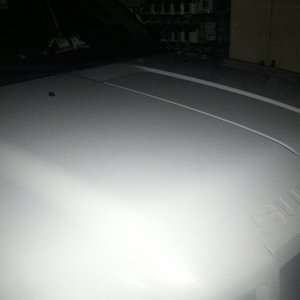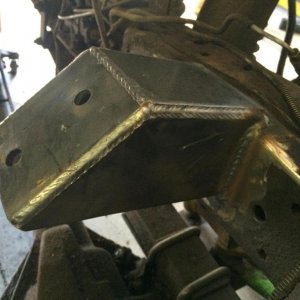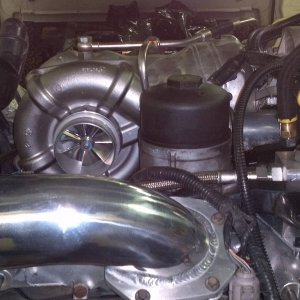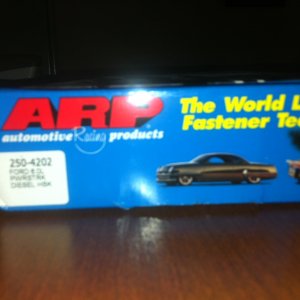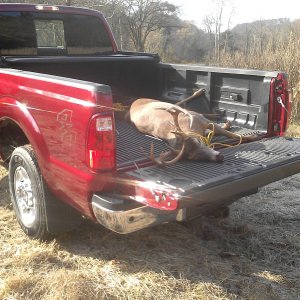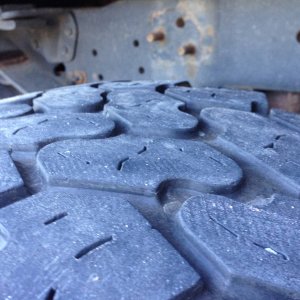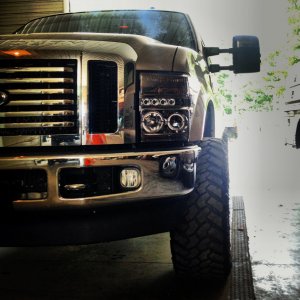I was questioning my coolant filter last night, there was no flow coming out of it at idle. I started pinching hoses to get flow, but nothing. Then I got inside and revved it a bit to burp system and I saw it flow finally. So it flows good at anything but idle. I was puzzled cause the filter was streaming hot, but now I know it flows above 1500 rpm
You are using an out of date browser. It may not display this or other websites correctly.
You should upgrade or use an alternative browser.
You should upgrade or use an alternative browser.
Who else runs hot?
- Thread starter DEEZUZ
- Start date
lincolnlocker
Well-known member
I was questioning my coolant filter last night, there was no flow coming out of it at idle. I started pinching hoses to get flow, but nothing. Then I got inside and revved it a bit to burp system and I saw it flow finally. So it flows good at anything but idle. I was puzzled cause the filter was streaming hot, but now I know it flows above 1500 rpm
how long has it been on there? I would think that it should flow some at idle.
live life full throttle
I was re-reading what you wrote related to the bypass filter flow: Did you pull the outlet hose coming off the bypass filter or did you pull the feed line? I read it as you checked the flow that was leaving the bypass filter? correct? A quick way to check if you have the ball valves on the inlet/outlet of the bypass is to cut off the outlet valve. Remove the filter and put a bucket under it. Then start the engine. You should have a nice solid flow.
It is t'd into the line that's atop the water pump, which I think is a return line. Can't remember why I put it there, probably to avoid teh rub through.
Thats the line that goes to the heater core. Or are you talking about the hose going to the thermostat housing? Either way, why not pull a plug from the pump body and route the filter into a better area.
I dont want to take from the topic of discussion but where did you mount the filter head?
The typical way to plumb the bypass is:
Port below the.t-stat housing on drivers side out to the bypass.
Out of the bypass into the heater hose port on top of pump under the hpop bolt port or into.the line going to.the.degas bottle. I prefer the prior as you are not bypassing the t-stat function in anyway.
If you have it as a loop off the heater return hose only i.e. both in and out of the same hose. With that setup you have.the same.pressure and.flow at.both in/out ports and thus very slow to no flow thru the bypass loop.
Port below the.t-stat housing on drivers side out to the bypass.
Out of the bypass into the heater hose port on top of pump under the hpop bolt port or into.the line going to.the.degas bottle. I prefer the prior as you are not bypassing the t-stat function in anyway.
If you have it as a loop off the heater return hose only i.e. both in and out of the same hose. With that setup you have.the same.pressure and.flow at.both in/out ports and thus very slow to no flow thru the bypass loop.
Last edited:
OBS-Addiction97
Member
TARM, I read you post on the previous page about running the 203* stat and proper oil operating tempatures. I also saw some one ask this same question, do you feel the oil temps will rise quicker with a modified truck ( injectors, hpop, oil
Ect) vs a stock 7.3?
The reason I'm asking is because I'm running the 203* at the moment along with a bunch of mods. I don't want to cook my engine when I'm running the crap out of it. If a 180* or even the stock 195* will keep the oil in a better range then it seems like cheap insurance.
Ect) vs a stock 7.3?
The reason I'm asking is because I'm running the 203* at the moment along with a bunch of mods. I don't want to cook my engine when I'm running the crap out of it. If a 180* or even the stock 195* will keep the oil in a better range then it seems like cheap insurance.
TARM, I read you post on the previous page about running the 203* stat and proper oil operating tempatures. I also saw some one ask this same question, do you feel the oil temps will rise quicker with a modified truck ( injectors, hpop, oil
Ect) vs a stock 7.3?
The reason I'm asking is because I'm running the 203* at the moment along with a bunch of mods. I don't want to cook my engine when I'm running the crap out of it. If a 180* or even the stock 195* will keep the oil in a better range then it seems like cheap insurance.
People have experienced higher eot running a 203 deg thermostat. No secrets. Those same people experienced cooler eot by going to a 180.
On an obs if my oil temps were in the 210+ range consistently, I would explore that option as the obs have a smaller cooling system as I understand.
Edit: there is much speak of the boiling point of water in regards to oil temp. While the explanations do hold truth, having oil above that temperature simply isnt necessary as water begins to dissipate at much lower temps. But that is my opinion and observation. In regards to oil anyway. However, does water dry up on hot surfaces during warmer temps? Like a hot piece of metal? Yes.
Last edited:
Today's oils there are no worries in terms of "cooking" your oils. So much of these worries is a carry over from the old engine days where 180 even 160 degree Tstats were the norm along with finding that sludge in your engines. Back when Carbs and points were the norm not fuel injection and electronic ignition.
Oil temps in the pan should be ideally 212-230 degrees. At peak it can go higher and of course until you warm up, lower. The point is ideal oil temps are in this range. I did a quick check to see if I could pull up some of my old Diesel data on oil temps but I must have them on a different PC. It showed engine wear at the various temps etc and what range offered the best wear plus efficiency etc.. I did a quick check and found some data from Cummins. Its actually on big rig fuel economy but in one of the graphs they show what is suppose to be "normal" oil temp. That temp is 230F. Also you will note that this is temp in the oil pan not the in the engine block say before the oil cooler where it will be even higher for a short period. Point being this is considered normal.
Here is the link and go down to page 13 where the graph is labeled "Effects of Lubricant Temperature and Performance" https://cumminsengines.com/uploads/docs/cummins_secrets_of_better_fuel_economy.pdf What they are going into there is how because syn have higher flow ability at low temps they help fuel econ but forget all that as its not what were are looking for here. Look at the oil temp range and what is considered normal and thus what cummins sets there engines to reach and maintain for oil temps.
So if you look at a 203 and a 195 first off were are only talking about 8 degrees here its not some huge variation like going from say a 203 to a 180. 203 would be fully open around 215-220. For cruising and low load its very possible and likely the Tstat will never fully open as it stay cool enough. But we are looking at peak effects. So 220. Figure oil temp of 10-15 over that so 230-235. So that is your under reasonably heavier loads.
Further if we take a look at stock tuning calibrations timing is not cut back until oil temps reach 260 degrees and that is again at the hpop. So I think it would be safe to say that is too hot at least in terms of the HEUI system and conventional oils.
There are plenty of trucks even those with hybrid injectors turbo custom tunes that run lower oil temps than coolant temps at all times other than under heavy loads ( towing etc) or hard runs. Something to consider when you are thinking about how well your oil cooler is working also consider what your EGTS are looking like as that can also give you an idea of how much more heat you are seeing.
I saw data from a guy that had some typical performance upgrades custom tunes etc running a CGW of 18000. He basically floored up a huge very long steep grade up to a peak elevation of 11K It was something like a 10-12 min run straight. EGTS were running constant at over 1300 F His oil temp peaked @ 253. Same rig going over Vail pass slightly lower and and less grade only hit 230F same load. Cruising on more normal grades same load was around 200-205.
At those temps the T-stat temp would have made no difference as a 203 even a 205 T-stat would have been fully open. But it does give you an idea of the range these engines can see from light cruising to full out maxed running harder that you likely really should push things regularly. Temps can vary wildly depending of conditions. Point is for them to get so hot as their is an issue the T-stat is not going to be in play unless you have a clogged oil cooler.
Also do not forget when you are comparing temps people post to know here the temp is being taken from. IH and Ford take if from the HPOP res. Obviously if you pull from the block before the cooler are you going to see higher temps than just about anywhere else in terms of readings
Oil temps in the pan should be ideally 212-230 degrees. At peak it can go higher and of course until you warm up, lower. The point is ideal oil temps are in this range. I did a quick check to see if I could pull up some of my old Diesel data on oil temps but I must have them on a different PC. It showed engine wear at the various temps etc and what range offered the best wear plus efficiency etc.. I did a quick check and found some data from Cummins. Its actually on big rig fuel economy but in one of the graphs they show what is suppose to be "normal" oil temp. That temp is 230F. Also you will note that this is temp in the oil pan not the in the engine block say before the oil cooler where it will be even higher for a short period. Point being this is considered normal.
Here is the link and go down to page 13 where the graph is labeled "Effects of Lubricant Temperature and Performance" https://cumminsengines.com/uploads/docs/cummins_secrets_of_better_fuel_economy.pdf What they are going into there is how because syn have higher flow ability at low temps they help fuel econ but forget all that as its not what were are looking for here. Look at the oil temp range and what is considered normal and thus what cummins sets there engines to reach and maintain for oil temps.
So if you look at a 203 and a 195 first off were are only talking about 8 degrees here its not some huge variation like going from say a 203 to a 180. 203 would be fully open around 215-220. For cruising and low load its very possible and likely the Tstat will never fully open as it stay cool enough. But we are looking at peak effects. So 220. Figure oil temp of 10-15 over that so 230-235. So that is your under reasonably heavier loads.
Further if we take a look at stock tuning calibrations timing is not cut back until oil temps reach 260 degrees and that is again at the hpop. So I think it would be safe to say that is too hot at least in terms of the HEUI system and conventional oils.
There are plenty of trucks even those with hybrid injectors turbo custom tunes that run lower oil temps than coolant temps at all times other than under heavy loads ( towing etc) or hard runs. Something to consider when you are thinking about how well your oil cooler is working also consider what your EGTS are looking like as that can also give you an idea of how much more heat you are seeing.
I saw data from a guy that had some typical performance upgrades custom tunes etc running a CGW of 18000. He basically floored up a huge very long steep grade up to a peak elevation of 11K It was something like a 10-12 min run straight. EGTS were running constant at over 1300 F His oil temp peaked @ 253. Same rig going over Vail pass slightly lower and and less grade only hit 230F same load. Cruising on more normal grades same load was around 200-205.
At those temps the T-stat temp would have made no difference as a 203 even a 205 T-stat would have been fully open. But it does give you an idea of the range these engines can see from light cruising to full out maxed running harder that you likely really should push things regularly. Temps can vary wildly depending of conditions. Point is for them to get so hot as their is an issue the T-stat is not going to be in play unless you have a clogged oil cooler.
Also do not forget when you are comparing temps people post to know here the temp is being taken from. IH and Ford take if from the HPOP res. Obviously if you pull from the block before the cooler are you going to see higher temps than just about anywhere else in terms of readings
Today's oils there are no worries in terms of "cooking" your oils. So much of these worries is a carry over from the old engine days where 180 even 160 degree Tstats were the norm along with finding that sludge in your engines. Back when Carbs and points were the norm not fuel injection and electronic ignition.
Oil temps in the pan should be ideally 212-230 degrees. At peak it can go higher and of course until you warm up, lower. The point is ideal oil temps are in this range. I did a quick check to see if I could pull up some of my old Diesel data on oil temps but I must have them on a different PC. It showed engine wear at the various temps etc and what range offered the best wear plus efficiency etc.. I did a quick check and found some data from Cummins. Its actually on big rig fuel economy but in one of the graphs they show what is suppose to be "normal" oil temp. That temp is 230F. Also you will note that this is temp in the oil pan not the in the engine block say before the oil cooler where it will be even higher for a short period. Point being this is considered normal.
Here is the link and go down to page 13 where the graph is labeled "Effects of Lubricant Temperature and Performance" https://cumminsengines.com/uploads/docs/cummins_secrets_of_better_fuel_economy.pdf What they are going into there is how because syn have higher flow ability at low temps they help fuel econ but forget all that as its not what were are looking for here. Look at the oil temp range and what is considered normal and thus what cummins sets there engines to reach and maintain for oil temps.
So if you look at a 203 and a 195 first off were are only talking about 8 degrees here its not some huge variation like going from say a 203 to a 180. 203 would be fully open around 215-220. For cruising and low load its very possible and likely the Tstat will never fully open as it stay cool enough. But we are looking at peak effects. So 220. Figure oil temp of 10-15 over that so 230-235. So that is your under reasonably heavier loads.
Further if we take a look at stock tuning calibrations timing is not cut back until oil temps reach 260 degrees and that is again at the hpop. So I think it would be safe to say that is too hot at least in terms of the HEUI system and conventional oils.
There are plenty of trucks even those with hybrid injectors turbo custom tunes that run lower oil temps than coolant temps at all times other than under heavy loads ( towing etc) or hard runs. Something to consider when you are thinking about how well your oil cooler is working also consider what your EGTS are looking like as that can also give you an idea of how much more heat you are seeing.
I saw data from a guy that had some typical performance upgrades custom tunes etc running a CGW of 18000. He basically floored up a huge very long steep grade up to a peak elevation of 11K It was something like a 10-12 min run straight. EGTS were running constant at over 1300 F His oil temp peaked @ 253. Same rig going over Vail pass slightly lower and and less grade only hit 230F same load. Cruising on more normal grades same load was around 200-205.
At those temps the T-stat temp would have made no difference as a 203 even a 205 T-stat would have been fully open. But it does give you an idea of the range these engines can see from light cruising to full out maxed running harder that you likely really should push things regularly. Temps can vary wildly depending of conditions. Point is for them to get so hot as their is an issue the T-stat is not going to be in play unless you have a clogged oil cooler.
Also do not forget when you are comparing temps people post to know here the temp is being taken from. IH and Ford take if from the HPOP res. Obviously if you pull from the block before the cooler are you going to see higher temps than just about anywhere else in terms of readings
You realize when the thermostat opens sooner, ie, a 180, 192, 195, etc the coolant has more chance to be cooled than a system llimitd by a 203deg tstat?
All of that scientific data is fine but you dont realize at 100 degrees the system has been missing full cooling for lets say 5 minutes. With higher, numerically opening, tstats the oil gets hot BEFORE the cooling system is allowed to "do its thing"?
Yes I do understand please do not assume I do not. Why in the world would you want to cool a system @ 100 degrees first of all? LOL I think you must have meant 200 degrees (easy typo as I am full of those LOL) But yes I understand what you are trying to say.
But that is one of the main points of a T-stat, is it not? To prevent extra cooling to allow the engine including the oil to get to it proper operating temp quickly and before cooling. We want the oil to get up to 200 degrees ( 212 actually would be ideal). Then the coolant which would be very close to ambient temp in the radiator starts to flow into the engine. The system on these trucks have huge cooling capacities.
I think its understood that we want the oil to get up to temp as quickly as possible The engines coolant system in every properly running engine I have seen gets up to t-stat operating (opening temp) temp long before the oil does. This is actually by design as it helps bring the oil up to temp quicker via the two way transfer of energy in this case heat between the two fluids.
Again these system are spec'd to run where oil temps should never be over 20 degree of coolant temp. If it is not ( is larger) then there is an issue with the cooler. If the spread is met then what is the point? It means everything is working correctly in terms of coolant to oil temps. Now if they are both too high say coolant 240 oil 260 ( just as an example) Then this is an issue with the cooling system not the oil cooler. Something is preventing the cooling of the coolant i.e stuck Tstat, blocked radiator, fan clutch etc
It does make your (my) head go in circles as you flip things around and around think about them. It certainly does mine LOL
The only time what you are saying could come into play is if you have a system where the oil temp in ratio to the coolant temp is outside that range of 15-20 degree maximum but it would have to be below the full opening of the T-stat temp. It would means the oil cooler for whatever reason was not keeping up with the cooling of the oil at the typical temp spread and so its getting hotter and hotter yet the coolant temp is some how staying at a temp that is below its full open. The reason it would have to be below fully open or only doing this during short peak load event is that even if it did start to cool it a bit sooner such as using a lower rated T-stat say180 by opening sooner eventually in a steady state condition such as towing down the highway for say an hour or even 30 mins or less it would eventually over take any head start opening early gave it. Once its fully open its fully open. So if its peaking way over the 20 degree spread with a 195 or 203 when they are fully open eventually its going to do it with any or even no Tstat at all. Thus for this to apply it would have to be with a scenario where the tstat was staying in a range were it was open but not fully yet oil temps were still exceeding the 20 degree spread.
As an example lets say its doing this with a 195 but at temp were the 195 is not even fully open say 205. So basically the oil cooler does not have the capacity to transfer enough heat to the coolant to drop the oil temp enough to keep it within the 20 degrees and that oil temp is already too high. Yet its coolant side cooling is enough to keep the coolant at that temp steady without going up.
So lets hypothetically say that we had and engine that the oil cooler just was that way or say it was perfect and something like a defect in the oil passages etc whatever take your pick was causing oil to be hotter, creating a spread larger even at cruising speeds. So say you are seeing oil temp of 250 with coolant temps of 205 degree running a 195 degree T-stat. OK so we can see that the coolant temp is still below the level of even being fully open yet the oil temp is still too high. We have gone thru everything in the engine we can without pulling the damn thing and we just want it to keep running and keep oil temps in proper range. Oil pressure seems good and flow rate is fine also ( obviously if passages were somehow restricted this may have other issue in terms of lubrication etc but lets assume its all OK) In that situation yes I fully agree going to a lower T-stat opening makes complete sense as something to keep things in range. It will give more coolant and and thus a even larger temp difference across the oil cooler and help drop those temps lower.
But again that is certainly the very rare exception to the general state of things with 7.3s. And if we are going to be debating the odd man out there we could basically make exceptions for most everything. But yes I would agree that in those cases one fix would certainly be to use a lower rated T stat to keep oil in its proper range. The only possible down side would be low heater performance and I will take keeping my engine running over a a bit cooler heat coming out of my vents. But this is again certainly not the norm or the way the 7.3 was oil cooling system was designed to perform in relation to the coolant system. All the various engine have a oil to coolant temp range spread. The 7.3 20 degrees I think the 6.0 and 6.4 is suppose to be 15 degrees and I am not aware of what the 6.7 is but I would guess close to the same or maybe they have some sort of electronic t-stat I honestly do not know. All of these engines are suppose to hold this ratio irregardless of the temp and its the T-stat that controls what the actual temp of that 15 degree spread is. THere is nothing different about the 7.3 in terms of this function.
But that is one of the main points of a T-stat, is it not? To prevent extra cooling to allow the engine including the oil to get to it proper operating temp quickly and before cooling. We want the oil to get up to 200 degrees ( 212 actually would be ideal). Then the coolant which would be very close to ambient temp in the radiator starts to flow into the engine. The system on these trucks have huge cooling capacities.
I think its understood that we want the oil to get up to temp as quickly as possible The engines coolant system in every properly running engine I have seen gets up to t-stat operating (opening temp) temp long before the oil does. This is actually by design as it helps bring the oil up to temp quicker via the two way transfer of energy in this case heat between the two fluids.
Again these system are spec'd to run where oil temps should never be over 20 degree of coolant temp. If it is not ( is larger) then there is an issue with the cooler. If the spread is met then what is the point? It means everything is working correctly in terms of coolant to oil temps. Now if they are both too high say coolant 240 oil 260 ( just as an example) Then this is an issue with the cooling system not the oil cooler. Something is preventing the cooling of the coolant i.e stuck Tstat, blocked radiator, fan clutch etc
It does make your (my) head go in circles as you flip things around and around think about them. It certainly does mine LOL
The only time what you are saying could come into play is if you have a system where the oil temp in ratio to the coolant temp is outside that range of 15-20 degree maximum but it would have to be below the full opening of the T-stat temp. It would means the oil cooler for whatever reason was not keeping up with the cooling of the oil at the typical temp spread and so its getting hotter and hotter yet the coolant temp is some how staying at a temp that is below its full open. The reason it would have to be below fully open or only doing this during short peak load event is that even if it did start to cool it a bit sooner such as using a lower rated T-stat say180 by opening sooner eventually in a steady state condition such as towing down the highway for say an hour or even 30 mins or less it would eventually over take any head start opening early gave it. Once its fully open its fully open. So if its peaking way over the 20 degree spread with a 195 or 203 when they are fully open eventually its going to do it with any or even no Tstat at all. Thus for this to apply it would have to be with a scenario where the tstat was staying in a range were it was open but not fully yet oil temps were still exceeding the 20 degree spread.
As an example lets say its doing this with a 195 but at temp were the 195 is not even fully open say 205. So basically the oil cooler does not have the capacity to transfer enough heat to the coolant to drop the oil temp enough to keep it within the 20 degrees and that oil temp is already too high. Yet its coolant side cooling is enough to keep the coolant at that temp steady without going up.
So lets hypothetically say that we had and engine that the oil cooler just was that way or say it was perfect and something like a defect in the oil passages etc whatever take your pick was causing oil to be hotter, creating a spread larger even at cruising speeds. So say you are seeing oil temp of 250 with coolant temps of 205 degree running a 195 degree T-stat. OK so we can see that the coolant temp is still below the level of even being fully open yet the oil temp is still too high. We have gone thru everything in the engine we can without pulling the damn thing and we just want it to keep running and keep oil temps in proper range. Oil pressure seems good and flow rate is fine also ( obviously if passages were somehow restricted this may have other issue in terms of lubrication etc but lets assume its all OK) In that situation yes I fully agree going to a lower T-stat opening makes complete sense as something to keep things in range. It will give more coolant and and thus a even larger temp difference across the oil cooler and help drop those temps lower.
But again that is certainly the very rare exception to the general state of things with 7.3s. And if we are going to be debating the odd man out there we could basically make exceptions for most everything. But yes I would agree that in those cases one fix would certainly be to use a lower rated T stat to keep oil in its proper range. The only possible down side would be low heater performance and I will take keeping my engine running over a a bit cooler heat coming out of my vents. But this is again certainly not the norm or the way the 7.3 was oil cooling system was designed to perform in relation to the coolant system. All the various engine have a oil to coolant temp range spread. The 7.3 20 degrees I think the 6.0 and 6.4 is suppose to be 15 degrees and I am not aware of what the 6.7 is but I would guess close to the same or maybe they have some sort of electronic t-stat I honestly do not know. All of these engines are suppose to hold this ratio irregardless of the temp and its the T-stat that controls what the actual temp of that 15 degree spread is. THere is nothing different about the 7.3 in terms of this function.
Last edited:
Yea. Thats stuff is all outside what Im talking about. Hook a 10klb trailer on a truck with each thermostat. Lemme know what you think then. Once that tstat opens, it doesnt matter what one you picked.
With a 180 degree you have a fighting chance of keeping oil below 250 degrees when its 95 and humid out. I ran a higher temp tstat and it did exactly what Im saying. The ten minutes longer it took to open accumulates too much heat before the system opens fully.
I have argued with people constantly and it flat out is the truth. Ask Joe, ask jake (lincolnlocker) . They both had the same results.
I suppose if a truck is going to the grocery store empty, it doesnt matter. On a truck that is gonna be worked in climates that reach above 90° it absolutely matters. Hence the creation of the 180 deg tstat.
With a 190 deg tstat my oil still hits 220 degrees when its hot outside. The argument that the 203 is oem doesnt matter either as a truck rated for 230 hp isnt making heat like a tuned 7.3 or god forbid larger hybrids.
Im not looking to get in a internet slugfest with ya Tarm I just dont think you're seeing where my point lies. No biggie. I only spoke up because Ive been there, seen it.
With a 180 degree you have a fighting chance of keeping oil below 250 degrees when its 95 and humid out. I ran a higher temp tstat and it did exactly what Im saying. The ten minutes longer it took to open accumulates too much heat before the system opens fully.
I have argued with people constantly and it flat out is the truth. Ask Joe, ask jake (lincolnlocker) . They both had the same results.
I suppose if a truck is going to the grocery store empty, it doesnt matter. On a truck that is gonna be worked in climates that reach above 90° it absolutely matters. Hence the creation of the 180 deg tstat.
With a 190 deg tstat my oil still hits 220 degrees when its hot outside. The argument that the 203 is oem doesnt matter either as a truck rated for 230 hp isnt making heat like a tuned 7.3 or god forbid larger hybrids.
Im not looking to get in a internet slugfest with ya Tarm I just dont think you're seeing where my point lies. No biggie. I only spoke up because Ive been there, seen it.
I have done exactly what you are talking about and I have seen the results as well. I know I am throwing tech stuff out there and I am certainly not doing it as means of talking down to or way to win an argument. It was done to help pass on info and increase peoples knowledge.
I said I do agree that a T stat opening sooner can be used to get ahead of a temp peak such as a heavy load going up a incline for a few mins.
I have yet to see people have these issues that had coolant and oil temps within the 20 degree range.
I am only guessing here but when your oil temp was 250 your coolant temp was not up to 230 was it? So it was lower?
Did you ever change out or pull your oil cooler and check all the passages?
I am being sincere here. I have no wish to just win some argument. Its stupid. I honestly want real data and compare my experince and knowledge with those of others. I can lay out all the data in the world but if I can not find out why it does or does not match up with real world stats what good is it!?!
I honestly have not come across a single situation in the 7.3 where if the oil temp was way out of range from the coolant it was not an issue with the oil cooler or running very high egts etc.. There has always been some issue. One was the block had been filled a good bit. That surely is not to indicate that this is the only answer and I have seen it all. Far from it. Only that so far all of these do line up with the info and what you call the " science" of it all.
That is what my experience has been. The transfer of heat to and from the coolant and oil is setup in terms of size of the oil cooler to handle the volume and flow rate from both pumps ( LPOP and coolant pump) to keep the rates within that range. But this is only if all the passages in the block and oil cooler are not restricted. If its all good then every time I have seen the oil cooler or the ports leading into it was restricted.
In the end we can both talk to we are blue in the face. If you have a 180 T stat and it keeps your oil above 190-212 at very light loads such as cruising 1900 rpms and also keeps it under 250 then it works plan and simple. Hard to argue with that in terms of real world results.
I said I do agree that a T stat opening sooner can be used to get ahead of a temp peak such as a heavy load going up a incline for a few mins.
I have yet to see people have these issues that had coolant and oil temps within the 20 degree range.
I am only guessing here but when your oil temp was 250 your coolant temp was not up to 230 was it? So it was lower?
Did you ever change out or pull your oil cooler and check all the passages?
I am being sincere here. I have no wish to just win some argument. Its stupid. I honestly want real data and compare my experince and knowledge with those of others. I can lay out all the data in the world but if I can not find out why it does or does not match up with real world stats what good is it!?!
I honestly have not come across a single situation in the 7.3 where if the oil temp was way out of range from the coolant it was not an issue with the oil cooler or running very high egts etc.. There has always been some issue. One was the block had been filled a good bit. That surely is not to indicate that this is the only answer and I have seen it all. Far from it. Only that so far all of these do line up with the info and what you call the " science" of it all.
That is what my experience has been. The transfer of heat to and from the coolant and oil is setup in terms of size of the oil cooler to handle the volume and flow rate from both pumps ( LPOP and coolant pump) to keep the rates within that range. But this is only if all the passages in the block and oil cooler are not restricted. If its all good then every time I have seen the oil cooler or the ports leading into it was restricted.
In the end we can both talk to we are blue in the face. If you have a 180 T stat and it keeps your oil above 190-212 at very light loads such as cruising 1900 rpms and also keeps it under 250 then it works plan and simple. Hard to argue with that in terms of real world results.
I have done exactly what you are talking about and I have seen the results as well. I know I am throwing tech stuff out there and I am certainly not doing it as means of talking down to or way to win an argument. It was done to help pass on info and increase peoples knowledge.
I said I do agree that a T stat opening sooner can be used to get ahead of a temp peak such as a heavy load going up a incline for a few mins.
I have yet to see people have these issues that had coolant and oil temps within the 20 degree range.
I am only guessing here but when your oil temp was 250 your coolant temp was not up to 230 was it? So it was lower?
Did you ever change out or pull your oil cooler and check all the passages?
I am being sincere here. I have no wish to just win some argument. Its stupid. I honestly want real data and compare my experince and knowledge with those of others. I can lay out all the data in the world but if I can not find out why it does or does not match up with real world stats what good is it!?!
I honestly have not come across a single situation in the 7.3 where if the oil temp was way out of range from the coolant it was not an issue with the oil cooler or running very high egts etc.. There has always been some issue. One was the block had been filled a good bit. That surely is not to indicate that this is the only answer and I have seen it all. Far from it. Only that so far all of these do line up with the info and what you call the " science" of it all.
That is what my experience has been. The transfer of heat to and from the coolant and oil is setup in terms of size of the oil cooler to handle the volume and flow rate from both pumps ( LPOP and coolant pump) to keep the rates within that range. But this is only if all the passages in the block and oil cooler are not restricted. If its all good then every time I have seen the oil cooler or the ports leading into it was restricted.
In the end we can both talk to we are blue in the face. If you have a 180 T stat and it keeps your oil above 190-212 at very light loads such as cruising 1900 rpms and also keeps it under 250 then it works plan and simple. Hard to argue with that in terms of real world results.
My oil cooler is in perfect condition. I just rebuilt it. A few passages were blocked but after rebuild the performance didnt change. My temps are no more than 15° apart and never have been.
I dont know about you but I can feel the oil when its that hot. The truck feels different. The pedal gets mushy. My truck is maintained and for just about everything barring operation in extreme cold, my money is on the 180 or close to it.
To each his own.
I prefer the 180* stat for summer and the 195* for winter... Problem is changing them sucks. I stuck with the 180* stat this winter and had no issue keeping oil temps at 200* when under load, empty they would hover around 185*-190*
My oil cooler is in perfect condition. I just rebuilt it. A few passages were blocked but after rebuild the performance didnt change. My temps are no more than 15° apart and never have been.
I dont know about you but I can feel the oil when its that hot. The truck feels different. The pedal gets mushy. My truck is maintained and for just about everything barring operation in extreme cold, my money is on the 180 or close to it.
To each his own.
If they stay in that range you are 110% correct your oil cooler is working as it should. That is why I was very careful about being sure to state this one part.
Hey I can understand if this is just going round and round for no good reason so if you want to be done with it I completely understand. But I am sort of interested in what could be allowing your cooling system to not keep up. As your temps are staying within the 20degree spread that means the oil cooler is properly working and offloading the heat to the coolant. For some reason though your coolant side of the system is not able to keep up.
Did you have this issue with the 195 and then went to the 180 or did you try the 203 and this happened? Reason I am wondering if say it was a 195 did you try another one at the same temp and get the same issues or did you just go to the 180? I am thinking maybe a Tstat not working properly anymore. Maybe not opening all the way or even properly?
Just curious but you mentioned the oil cooler was clogged before you rebuilt it. Was it both the oil and coolant side or just one or the other that was clogged?
What temps does your coolant and oil say at now with the 180, cruising and then again with that 10K trailer?
Yes I can without a doubt feel the difference with oil. Much in the same way you can when its dead cold and of course when its past due for a oil change. In some ways its a nice thing with these motors in terms of oil changes in that if you are in tune with how the engine runs you can tell when that oil is starting to lose its viscosity.
And do not worry about the extra questions if you do not care to look into this further. I just find it of interest but I do not expect you to. LOL
If they stay in that range you are 110% correct your oil cooler is working as it should. That is why I was very careful about being sure to state this one part.
Hey I can understand if this is just going round and round for no good reason so if you want to be done with it I completely understand. But I am sort of interested in what could be allowing your cooling system to not keep up. As your temps are staying within the 20degree spread that means the oil cooler is properly working and offloading the heat to the coolant. For some reason though your coolant side of the system is not able to keep up.
Did you have this issue with the 195 and then went to the 180 or did you try the 203 and this happened? Reason I am wondering if say it was a 195 did you try another one at the same temp and get the same issues or did you just go to the 180? I am thinking maybe a Tstat not working properly anymore. Maybe not opening all the way or even properly?
Just curious but you mentioned the oil cooler was clogged before you rebuilt it. Was it both the oil and coolant side or just one or the other that was clogged?
What temps does your coolant and oil say at now with the 180, cruising and then again with that 10K trailer?
Yes I can without a doubt feel the difference with oil. Much in the same way you can when its dead cold and of course when its past due for a oil change. In some ways its a nice thing with these motors in terms of oil changes in that if you are in tune with how the engine runs you can tell when that oil is starting to lose its viscosity.
And do not worry about the extra questions if you do not care to look into this further. I just find it of interest but I do not expect you to. LOL
Im not sure on all these details as the trucks had a 180 tstat for two years. I had a 192. Another 192. Then a 195 (which you have unless you didnt run the tstat I sent you) which I ordered from International for the IH waterpump. I purchased a 203° tstat and ran it from July 12 until September at which point we were stuck close to 100 degrees for two months and high oil temps were pissing me off. I was running mobil1 turbo diesel and my oci were about 4k miles. Its because with any kind of load I was cooking the oil out of the truck. Running 75 mph with 175/80s on 35s with 3.73s the engine heat was a little much. A 180 deg tstat kept my oil temps 220 or less. The point where apparently oil can live longer as my temps came down and I didnt need to change my oil every 2500 miles. I ran the truck like that for approximately the remainder of a calendae year and last fall I put a 195 in as my truck doesnt really do much these days. Pull a dump trailer. Probably 8-10k lbs total trailer weight but I use a towtune and it runs very cool. In fact that towtune flat to the floor on the climb to arlington with 18k lb of trailer never hit 1000° egt. Truck maintained 65mph too. Its something dumb like 40 or 60 hp tune, lol.
My truck has never been maintained miserly. Its always been do what needs done but the tstat deal did NOT work out for me. It was obvious what it was as my motor had been out and gone through/replaced everything. Had my radiator serviced. New fan clutch. Nothing is worn or malfunctioning.
I cang debate this anymore as Ive said my bit. My findings are in line with what Joe has said in other threads.
With a 195 tstat, empty, I can get the oil to 200 degrees in any ambient temp. Maybe 210 if I flog it.
Edit:I changed coolant and at the same time changed tstats which is why I changed the 180 after a year of service. If I was working the truck regularly, the 180 would have stayed in. No doubts.
Last edited:
Thank you and yes you sent me a 195 I recall you telling me that. I went and got a 180, 203 and a 205 just to see the difference in temps and open points ect.
Please, do not think I am debating anything with you. I have ZERO reason nor do I not believe everything you are telling me here; Seriously. You are only reporting based on the results you see right in front of your face every day, what is there to debate about that!?! LOL
Once you established that your oil and coolant were in range of each other all I wanted was to try and figure out what was different to cause them both to go so high compared to others. Basically why your results are what they are. I am not questioning the validity of your results at all. I am trying to learn from them. It why I stated not to feel in any way obligated to continue other than to help me learn what the difference might be to explain the variation and if you were interested as well.
Of course there could be all sorts of things. I was just hoping maybe if we looked at some basic things it could answer the "why" so no need to go on about it any further
I am glad your truck is working ok and you are at least not cooking your oil anymore. Also I was super happy with everything you sent me and how it all worked out for me. You saved me time and money. Its too bad the IH pump did not work with your dual alt setup as I know you put a good amount of time and $$ into it all. Everything worked fine for me. I had to file some casting on the lower inlet on the pump as the seam created just enough of a angle I thought it might not seal well but it was a 1 min thing. Very easy. No leaking and works well.
Best wishes.
Please, do not think I am debating anything with you. I have ZERO reason nor do I not believe everything you are telling me here; Seriously. You are only reporting based on the results you see right in front of your face every day, what is there to debate about that!?! LOL
Once you established that your oil and coolant were in range of each other all I wanted was to try and figure out what was different to cause them both to go so high compared to others. Basically why your results are what they are. I am not questioning the validity of your results at all. I am trying to learn from them. It why I stated not to feel in any way obligated to continue other than to help me learn what the difference might be to explain the variation and if you were interested as well.
Of course there could be all sorts of things. I was just hoping maybe if we looked at some basic things it could answer the "why" so no need to go on about it any further
I am glad your truck is working ok and you are at least not cooking your oil anymore. Also I was super happy with everything you sent me and how it all worked out for me. You saved me time and money. Its too bad the IH pump did not work with your dual alt setup as I know you put a good amount of time and $$ into it all. Everything worked fine for me. I had to file some casting on the lower inlet on the pump as the seam created just enough of a angle I thought it might not seal well but it was a 1 min thing. Very easy. No leaking and works well.
Best wishes.

